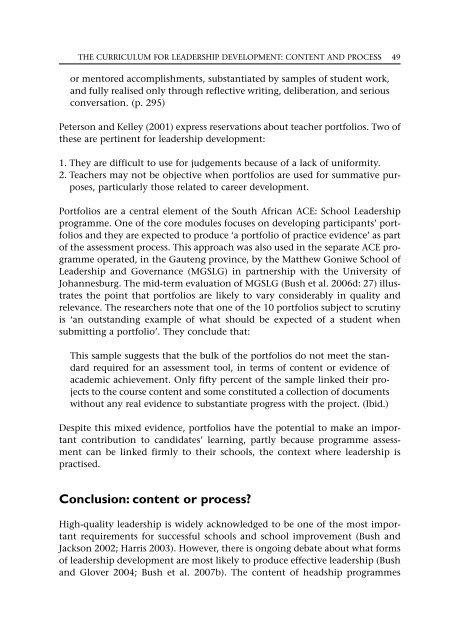Leadership and Management Development in Education (Education ...
Leadership and Management Development in Education (Education ...
Leadership and Management Development in Education (Education ...
Create successful ePaper yourself
Turn your PDF publications into a flip-book with our unique Google optimized e-Paper software.
THE CURRICULUM FOR LEADERSHIP DEVELOPMENT: CONTENT AND PROCESS49or mentored accomplishments, substantiated by samples of student work,<strong>and</strong> fully realised only through reflective writ<strong>in</strong>g, deliberation, <strong>and</strong> seriousconversation. (p. 295)Peterson <strong>and</strong> Kelley (2001) express reservations about teacher portfolios. Two ofthese are pert<strong>in</strong>ent for leadership development:1. They are difficult to use for judgements because of a lack of uniformity.2. Teachers may not be objective when portfolios are used for summative purposes,particularly those related to career development.Portfolios are a central element of the South African ACE: School <strong>Leadership</strong>programme. One of the core modules focuses on develop<strong>in</strong>g participants’ portfolios<strong>and</strong> they are expected to produce ‘a portfolio of practice evidence’ as partof the assessment process. This approach was also used <strong>in</strong> the separate ACE programmeoperated, <strong>in</strong> the Gauteng prov<strong>in</strong>ce, by the Matthew Goniwe School of<strong>Leadership</strong> <strong>and</strong> Governance (MGSLG) <strong>in</strong> partnership with the University ofJohannesburg. The mid-term evaluation of MGSLG (Bush et al. 2006d: 27) illustratesthe po<strong>in</strong>t that portfolios are likely to vary considerably <strong>in</strong> quality <strong>and</strong>relevance. The researchers note that one of the 10 portfolios subject to scrut<strong>in</strong>yis ‘an outst<strong>and</strong><strong>in</strong>g example of what should be expected of a student whensubmitt<strong>in</strong>g a portfolio’. They conclude that:This sample suggests that the bulk of the portfolios do not meet the st<strong>and</strong>ardrequired for an assessment tool, <strong>in</strong> terms of content or evidence ofacademic achievement. Only fifty percent of the sample l<strong>in</strong>ked their projectsto the course content <strong>and</strong> some constituted a collection of documentswithout any real evidence to substantiate progress with the project. (Ibid.)Despite this mixed evidence, portfolios have the potential to make an importantcontribution to c<strong>and</strong>idates’ learn<strong>in</strong>g, partly because programme assessmentcan be l<strong>in</strong>ked firmly to their schools, the context where leadership ispractised.Conclusion: content or process?High-quality leadership is widely acknowledged to be one of the most importantrequirements for successful schools <strong>and</strong> school improvement (Bush <strong>and</strong>Jackson 2002; Harris 2003). However, there is ongo<strong>in</strong>g debate about what formsof leadership development are most likely to produce effective leadership (Bush<strong>and</strong> Glover 2004; Bush et al. 2007b). The content of headship programmes
















